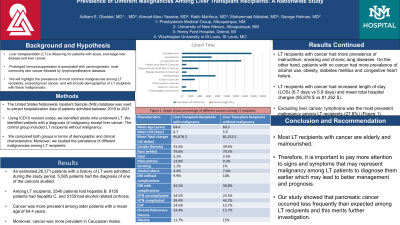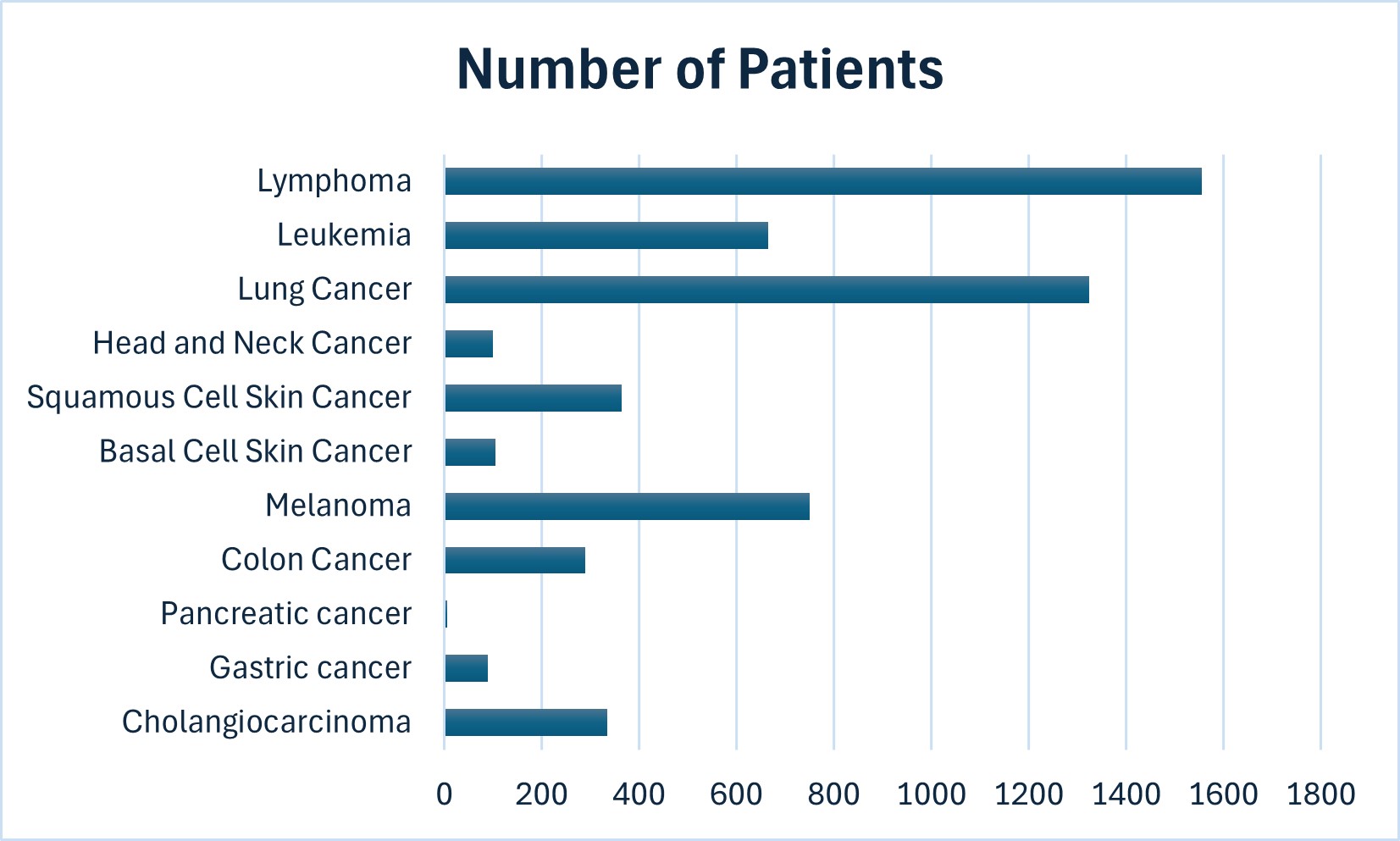Monday Poster Session
Category: Liver
P2966 - Prevalence of Different Malignancies Among Liver Transplant Recipients: A Nationwide Study
Monday, October 28, 2024
10:30 AM - 4:00 PM ET
Location: Exhibit Hall E

- AA
Ahmad Abou Yassine, MD
Staten Island University Hospital
Staten Island, NY
Presenting Author(s)
Adham Obeidat, MD1, Ahmad Abou Yassine, MD2, Ratib Mahfouz, MD3, George Holman, MD2, Mohammad Aldiabat, MD4
1Presbyterian Hospital, Albuquerque, NM; 2University of New Mexico, Albuquerque, NM; 3Henry Ford Hospital, Detroit, MI; 4Washington University in St. Louis, St. Louis, MO
Introduction: Liver transplantation (LT) is lifesaving for patients with acute, end-stage liver disease and liver cancer. Prolonged immunosuppression is associated with carcinogenesis, most commonly skin cancer followed by lymphoproliferative diseases. We will highlight the prevalence of most common malignancies among LT recipients, excluding liver cancer, and will include demographics of LT recipients with these malignancies.
Methods: The United States Nationwide Inpatient Sample (NIS) database was used to extract hospitalization data of patients admitted between 2019 to 2021. Using ICD10 revision codes, we identified adults who underwent LT. We identified patients with a diagnosis of malignancy except liver cancer. The control group included LT recipients without malignancy. We compared both groups in terms of demographic and clinical characteristics. Moreover, we studied the prevalence of different malignancies among LT recipients.
Results: An estimated 26,371 patients with a history of LT were admitted during the study period. 5,585 patients had the diagnosis of one of the cancers studied below. Among LT recipients, 2540 patients had hepatitis B, 9150 patients had hepatitis C and 5155 had alcohol related cirrhosis.
Cancer was more prevalent among older patients with a mean age of 64.4 years. Moreover, cancer was more prevalent in Caucasians and males. LT recipients with cancer had more prevalence of malnutrition, smoking and chronic lung diseases. On the other hand, patients with no cancer had more prevalence of alcohol use, obesity, diabetes mellitus and congestive heart failure. LT recipients with cancer had increased length of stay (LOS) (6.7 days vs 5.9 days) and mean total hospital charges (95,878 $ vs 81,252 $). Excluding liver cancer, lymphoma was the most prevalent malignancy among LT recipients (27.8%). This was followed by lung cancer (23.7%), melanoma (13.4%), leukemias (11.9%) and squamous cell cancer of the skin (6.5%). cholangiocarcinoma, colon cancer, basal cell skin cancer, gastric cancer and pancreatic cancer constitute the rest (Graph 1).
Discussion: Malignancy is a known complication in patients with LT. Most LT recipients with cancer are elderly and malnourished. Therefore, it is important to pay more attention to signs and symptoms that may represent malignancy among LT patients to diagnose them earlier for better management and prognosis. Our study showed that pancreatic cancer occurred less frequently than expected among LT recipients and this merits further investigation.

Disclosures:
Adham Obeidat, MD1, Ahmad Abou Yassine, MD2, Ratib Mahfouz, MD3, George Holman, MD2, Mohammad Aldiabat, MD4. P2966 - Prevalence of Different Malignancies Among Liver Transplant Recipients: A Nationwide Study, ACG 2024 Annual Scientific Meeting Abstracts. Philadelphia, PA: American College of Gastroenterology.
1Presbyterian Hospital, Albuquerque, NM; 2University of New Mexico, Albuquerque, NM; 3Henry Ford Hospital, Detroit, MI; 4Washington University in St. Louis, St. Louis, MO
Introduction: Liver transplantation (LT) is lifesaving for patients with acute, end-stage liver disease and liver cancer. Prolonged immunosuppression is associated with carcinogenesis, most commonly skin cancer followed by lymphoproliferative diseases. We will highlight the prevalence of most common malignancies among LT recipients, excluding liver cancer, and will include demographics of LT recipients with these malignancies.
Methods: The United States Nationwide Inpatient Sample (NIS) database was used to extract hospitalization data of patients admitted between 2019 to 2021. Using ICD10 revision codes, we identified adults who underwent LT. We identified patients with a diagnosis of malignancy except liver cancer. The control group included LT recipients without malignancy. We compared both groups in terms of demographic and clinical characteristics. Moreover, we studied the prevalence of different malignancies among LT recipients.
Results: An estimated 26,371 patients with a history of LT were admitted during the study period. 5,585 patients had the diagnosis of one of the cancers studied below. Among LT recipients, 2540 patients had hepatitis B, 9150 patients had hepatitis C and 5155 had alcohol related cirrhosis.
Cancer was more prevalent among older patients with a mean age of 64.4 years. Moreover, cancer was more prevalent in Caucasians and males. LT recipients with cancer had more prevalence of malnutrition, smoking and chronic lung diseases. On the other hand, patients with no cancer had more prevalence of alcohol use, obesity, diabetes mellitus and congestive heart failure. LT recipients with cancer had increased length of stay (LOS) (6.7 days vs 5.9 days) and mean total hospital charges (95,878 $ vs 81,252 $). Excluding liver cancer, lymphoma was the most prevalent malignancy among LT recipients (27.8%). This was followed by lung cancer (23.7%), melanoma (13.4%), leukemias (11.9%) and squamous cell cancer of the skin (6.5%). cholangiocarcinoma, colon cancer, basal cell skin cancer, gastric cancer and pancreatic cancer constitute the rest (Graph 1).
Discussion: Malignancy is a known complication in patients with LT. Most LT recipients with cancer are elderly and malnourished. Therefore, it is important to pay more attention to signs and symptoms that may represent malignancy among LT patients to diagnose them earlier for better management and prognosis. Our study showed that pancreatic cancer occurred less frequently than expected among LT recipients and this merits further investigation.

Figure: Graph shows different cancers prevalences among liver transplant recipients
Disclosures:
Adham Obeidat indicated no relevant financial relationships.
Ahmad Abou Yassine indicated no relevant financial relationships.
Ratib Mahfouz indicated no relevant financial relationships.
George Holman indicated no relevant financial relationships.
Mohammad Aldiabat indicated no relevant financial relationships.
Adham Obeidat, MD1, Ahmad Abou Yassine, MD2, Ratib Mahfouz, MD3, George Holman, MD2, Mohammad Aldiabat, MD4. P2966 - Prevalence of Different Malignancies Among Liver Transplant Recipients: A Nationwide Study, ACG 2024 Annual Scientific Meeting Abstracts. Philadelphia, PA: American College of Gastroenterology.
